Biology:Accretion model of Neanderthal origins
In Palaeoanthropology, the accretion model[1]:4 is a theory for the appearance of Neanderthals. It suggests that those traits characteristically Neanderthal appeared gradually (accreted) over hundreds of thousands of years, rather than abruptly.[1] First proposed by Piveteau (1970), it was developed by Vandermeersch (1978)[2] and Jean-Jacques Hublin (1982,[3] 1986,[4] 1998,[5] 2009a,b).[6][7]
The model proposes four descriptive stages for the appearance of Neanderthal characteristics.[7] According to those that defined the stages, these likely just reflect the discontinuity of the fossil record. For example, no specimen dates to OIS 8 (300–243 ka), so this gap serves to separate stages 2 and 3.[7]
| Stage | Name | Date | Traits (among others)[7] | Includes | Example 1 | Example 2 |
|---|---|---|---|---|---|---|
| Stage 1 | Early pre-Neanderthals |
OIS 12 and before
To 424 ka |
Wide occipital torus. | Arago (left, male) Petralona Mauer 1 |
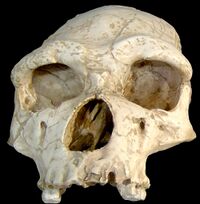
|
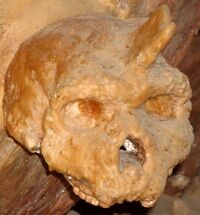
|
| Stage 2 | Pre-Neanderthals | OIS 11 to 9
424 – 300 ka |
Protruding occipital torus.
Incipient occipital bun. Increased occipital plane convexity. Incipient to well-defined suprainiac fossa. |
Atapuerca 5 (left, male) Steinheim 1 |
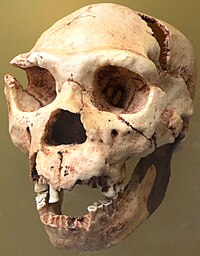
|
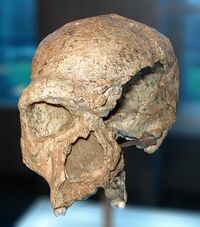
|
| Stage 3 | Early Neanderthals | OIS 7 to 5
243 – 71 ka |
Full occipital bun.
Pronounced occipital plane convexity. Elongated skull in the front-back direction. |
Saccopastore 1 (left, female) Krapina 3 |

|
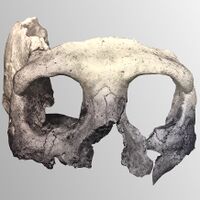
|
| Stage 4 | Classic Neanderthals | OIS 4 and 3
71 – 40 ka |
Orbits of the eyes become rounded.
Nose cavity becomes larger. Exaggerated occipital plane convexity. Exaggerated suprainiac fossa. Pronounced mid-facial prognathism. |
La Chapelle 1 (left, male) Gibraltar 1 |
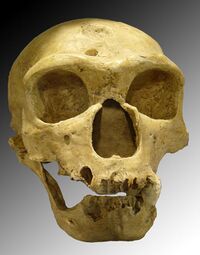
|
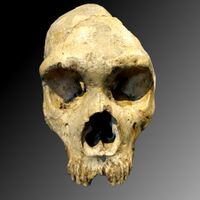
|
References
- ↑ Jump up to: 1.0 1.1 B. Wood, ed (2013). Wiley-Blackwell Encyclopedia of Human Evolution. Wiley-Blackwell. ISBN 978-1-118-65099-8.
- ↑ "Étude préliminaire du crâne humain du gisement paléolithique de Biache-Saint-Vaast (Pas-de-Calais)". Bulletin de l'Association française pour l'étude du Quaternaire 54-56: pp. 65–67. 1978.
- ↑ J.-J. Hublin (1982). "The myth of the European presapiens". Anthropos 9 (16).
- ↑ J.-J. Hublin (1986). "Some comments on the diagnostic features of Homo erectus". Anthropos (23): pp. 175–87.
- ↑ J.-J. Hublin (1998). "Climatic changes, paleogeography, and the evolution of the Neandertals". Neanderthals and modern humans in western Asia. New York: Plenum Press. pp. 295–310.
- ↑ J.-J. Hublin (2009). "The origin of Neandertals". Proceedings of the National Academy of Sciences USA 106 (38): pp. 16022–27. doi:10.1073/pnas.0904119106.
- ↑ Jump up to: 7.0 7.1 7.2 7.3 D. Dean; J.-J. Hublin; R. Holloway; R. Ziegler (1998). "On the phylogenetic position of the pre-Neandertal specimen from Reilingen, Germany". Journal of Human Evolution 34 (5): pp. 485–508. doi:10.1006/jhev.1998.0214.

